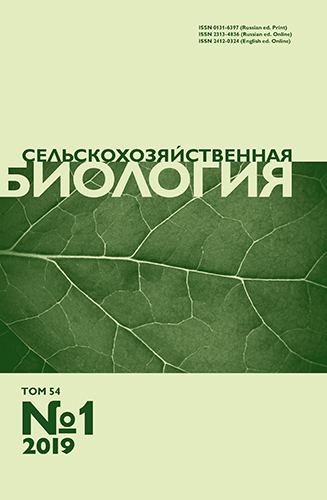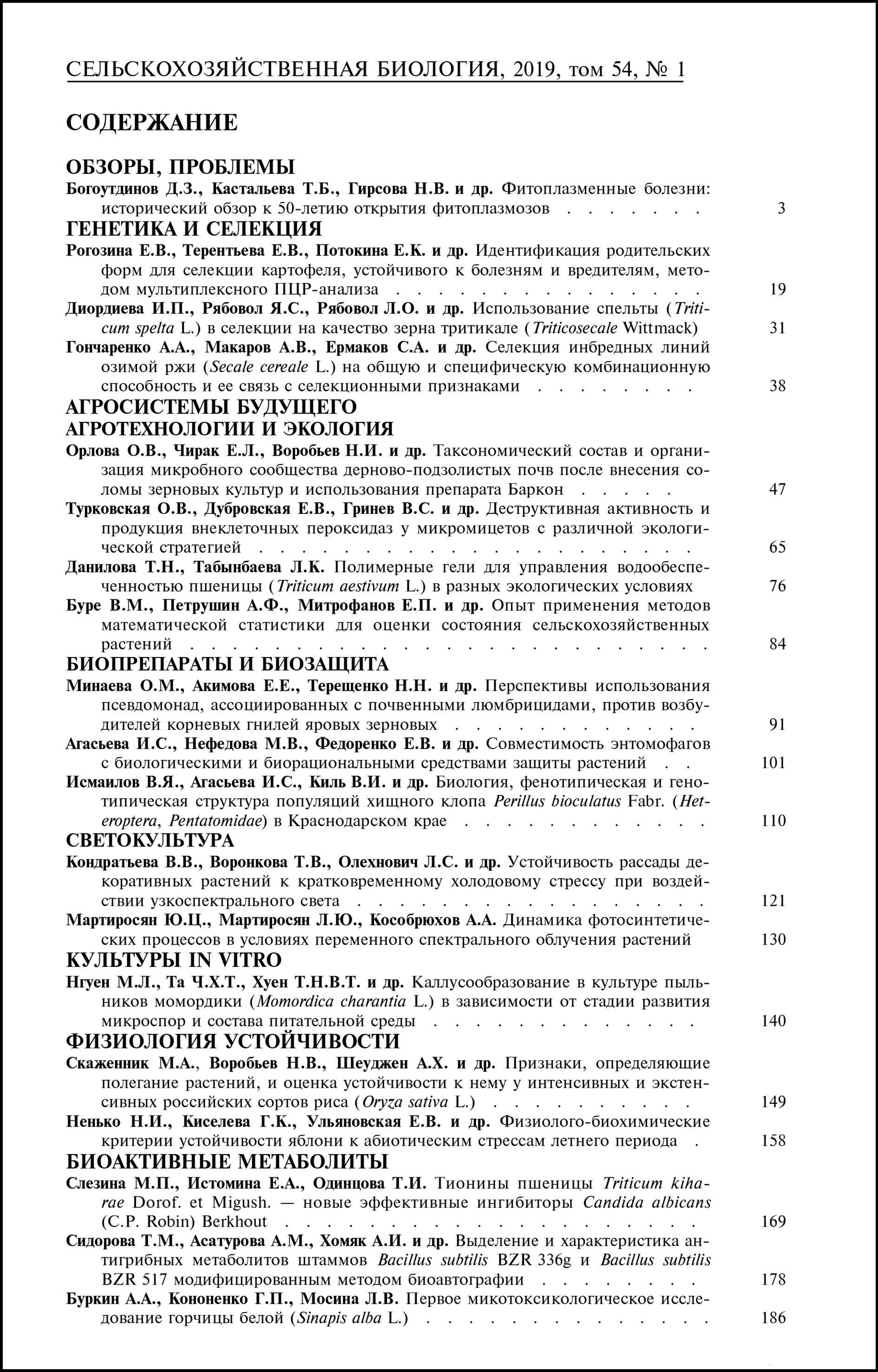doi: 10.15389/agrobiology.2019.1.140rus
УДК 635.6:576.3/.7.086.83:58
Исследование финансируется Фондами развития науки и технологии Университета Дананг по номеру проекта B2017-DN03-13.
КАЛЛУСООБРАЗОВАНИЕ В КУЛЬТУРЕ ПЫЛЬНИКОВ МОМОРДИКИ
(Momordica charantia L.) В ЗАВИСИМОСТИ ОТ СТАДИИ РАЗВИТИЯ
МИКРОСПОР И СОСТАВА ПИТАТЕЛЬНОЙ СРЕДЫ
М.Л. НГУЕН1, Ч.Х.Т. ТА1, Т.Н.В.Т. ХУЕН1, А.В. ВОРОНИНА2
Культура пыльников — один из эффективных методов создания чистых линий за короткое время. С его помощью можно ускорить процесс получения F1 гибридов момордики (Momordica charantia L., сем. Cucurbitaceae) — экономически важной сельскохозяйственной культуры, которую возделывают в тропических и субтропических странах Южной Америки, Азии и Африки. Достаточно эффективная технология культивирования пыльников момордики пока что не разработана. В настоящем исследовании мы показали, что размер бутонов достоверно (p ≤ 0,05) влияет на способность формирования каллусов момордики. Выявлено, что частота каллусообразования, морфология каллусов и время начала их формирования в культуре пыльников in vitro существенно зависят от состава и концентрации регуляторов роста в питательной среде. Кроме того, впервые исследована динамика каллусообразования в процессе культирования пыльников момордики. Целью работы было изучение влияния стадии развития микроспор и состава питательных среды на способность каллусообразования в культуре пыльников in vitro. В качестве материала использовали растения F1 гибрида момордики Diago 26. Растения выращивали в 2018 году в открытом грунте (уезд Дайлок, провинция Куангнам, Вьетнам) по общепринятой методике для получения товарных плодов. Бутоны отбирали в утренние часы (500-700) и хранили в полиэтиленовых пакетах при 4 °С в течение 1 сут. Бутоны поверхностно стерилизовали 70 % спиртом и 5 % раствором гипохлорита натрия (NaOCl). Пыльники извлекали из бутонов и помещали на питательные среды в чашки Петри. Культивирование осуществляли при температуре 25±2 °С с фотопериодом 16 ч день/8 ч ночь в течение 4 нед. Использовали три варианта питательной среды Мурасиге-Скуга, различающихся по составу и концентрации регуляторов роста: МК1 с добавлением 1,0 мг/л 2,4-Д (2,4-дихлорфеноксиуксусная кислота) и 1,5 мг/л БАП (6-бензиламинопурин); МК2 — 1,5 мг/л 2,4-Д и 1,0 мг/л БАП; МК3 — 1,5 мг/л НУК (1-нафталинуксусная кислота), 1,0 мг/л БАП и 0,5 мг/л кинетина. Статистическую обработку полученных данных проводили в программах IBM SPSS Statistics 22 и Microsoft Excel 2013. Выявлено, что в одном пыльнике содержались микроспоры на разных стадиях развития, поэтому ввести в культуру материал с микроспорами на одной определенной стадии невозможно. Однако можно выявить одну стадию развития, которая численно преобладает. Мы культивировали пыльники из бутонов, разделенных на две группы: бутоны длиной 4,0-5,0 мм, которые содержали ранние и средние одноядерные микроспоры, и бутоны длиной 5,1-6,5 мм, в которых находились поздние одноядерные и двуядерные микроспоры. При культивировании пыльников из бутонов длиной 4,0-5,0 мм каллусы формировались в течение 1 нед после введения в культуру, из бутонов размером 5,1-6,5 мм — в течение 2-й нед. Самую высокую частоту формирования каллусов (93,75±2,55 %) наблюдали при использовании питательной среды MS с добавлением 1,0 мг/л 2,4-Д и 1,5 мг/л БАП (МК1). Большая часть каллусов формировались на 2-й и 3-й нед культивирования. Также наблюдали существенное различие в морфологии каллусов, полученных на трех питательных средах разного состава. Каллусы на среде МК1 имели желтый цвет, очень плотную консистенцию, на МК2 — зеленый цвет и также очень плотную консистенцию, на МК3 — зелено-желтый цвет и консистенцию средней плотности. При этом мы не выявили влияния стадии развития микроспор на морфологию каллусов. Несмотря на значительное количество полученных каллусов, образование эмбриоидов мы не наблюдали.
Ключевые слова: Momordica charantia L., момордика, каллусообразование, удвоенные гаплоиды, культура пыльников.
M.L. Nguyen1, T.H.T. Ta1, T.N.B.T. Huyen1, A.V. Voronina2
Anther culture is one of the powerful techniques to pure line production for the short time. This method can be applied to accelerate the breeding process of F1 hybrids of bitter melon (Momordica charantia L., family Cucurbitaceae), which is an important commercial crop in tropical and subtropical countries of South America, Asia and Africa. Although, there are several factors affecting the success of this method, the effective protocol of bitter melon anther culture has not been developed at present. The results of this study showed that the microspore developmental stage has a significant (p ≤ 0.05) effect on speed and rate of callus formation. It was revealed that the frequency and the rate of callus formation and the morphology of callus substantially depend on the composition and concentration of growth regulators in the nutrient medium. In addition, the dynamics of callus formation in bitter melon anther culture was first studied. The main objective of the work was to study the influence of the microspore developmental stage and the composition of nutrient medium on the ability of callus formation in bitter melon anther culture in vitro. Plants of the F1 hybrid bitter melon Diago 26 were grown in field in Dailoc district, Quangnam province (Vietnam) in 2018 according to the standard technique for obtaining commercial fruits. The buds harvested at 5-7 am were stored in plastic bags in dark condition at 4 °С for 1 day. Before culturing of anther, flower buds were surfaced sterilized using 70 % ethanol and 5 % sodium hypochlorite (NaOCl). Anther removed from flower buds were inoculated in the induction medium in the horizontal laminar air flow; then incubated at 25±2 °С and a photoperiod of 16 h light/8 h dark for 4 weeks. Three variants of the Murashige-Skoog (MS) nutrient mediums were used, differing in composition and concentration of growth regulators: MK1 with the addition of 1.0 mg/l 2.4-D and 1.5 mg/l BAP; MK2 — 1.5 mg/l 2,4-D and 1.0 mg/l BAP; MK3 — 1.5 mg/l NAA, 1.0 mg/l BAP and 0.5 mg/l kinetin. The completely randomized design with statistical analysis using the software IBM SPSS Statistics Base 22 and Microsoft Excel 2013 were carried out. The cytological analysis result showed that each anther contained microspores with different development stages. Therefore, it is impossible to separate microspores at the unique developmental stage being suitable for anther culture; however, there is always a predominant stage. In this study, buds were divided into two main groups. The first group consisted of buds with the size of 4.0-5.0 mm with early and mid uninucleate microspores. The second group included buds with the size of 5.1-6.5 mm with late uninucleate and binucleate microspore. After inoculation, the beginning of calli formation was observed within the first week for anther of the buds with the size of 4.0-5.0 mm and within the second week for the buds with the size of 5.1-6.5 mm. The highest frequency of callus formation (93.75±2.55 %) was observed on MS medium supplemented with 1.0 mg/l of 2,4-D and 1.5 mg/l of BAP (MK1). Most calli were formed during the second and third week after cultivation. Also, there was the significant difference about the morphology of the calli obtained on three nutrient medium. Calli on medium MK1 were yellow, strongly dense and calli on MS medium with the addition of 1.5 mg/l of 2,4-D and 1,0 mg/l of BAP (MK2) being green, strongly dense. Green-yellow, dense calli were obtained on medium supplemented with 1.5 mg/l NAA and 1.0 mg/l BAP and 0.5 mg/l Kinetin (MK3). However, the effect of the developmental stage of microspores on the morphology of calli was not revealed. Despite receiving a large number of calli, the formation of embryoids was not observed.
Keywords: Momordica charantia L., bitter melon, callus, doubled haploid, anther culture,microspore stage.
1University of Education — The University of Da Nang, Vietnam, Danang city, 459 — Ton Duc Thang st., |
Поступила в редакцию |












